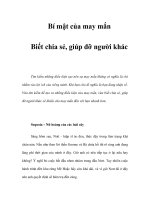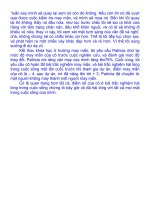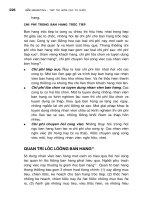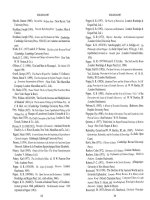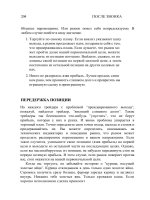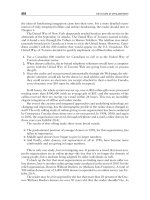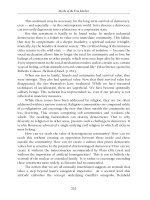Operational Risk Modeling Analytics phần 10 ppsx
Bạn đang xem bản rút gọn của tài liệu. Xem và tải ngay bản đầy đủ của tài liệu tại đây (2.38 MB, 46 trang )
MAXIMUM LIKELIHOOD ESTIMATION
397
dimension of the jth outcome. Then the loglikelihood function is
n
=
1,
+
I,.
(14.2)
The maximum likelihood estimates are the values of the parameters that
maximize the loglikelihood function. This form of the loglikelihood suggests
obtaining approximate estimates of the parameters by first maximizing the
first term (the. “marginals” term) and then maximizing the second term (the.
“copula” term). Maximizing the marginals term involves maximizing the
d
different terms in
1,
of the form
n
li
=
Clnfi(xi,j),
i
=
1,2
, ,
d
where (14.3) is the loglikelihood function of the ith marginal distribution.
Thus, we can first obtain all the parameter estimates for the marginal dis-
tributions using the univariate methods described earlier. It should be noted
that these are not the ultimate maximum likelihood estimates because the
ultimate estimates depend also on the estimates
of
the copula parameter(s)
which have not yet been estimated. We shall refer to the estimates arising
from the maximization of (14.3)
as.
“pseudo-MLEs.” The efficiency of these
estimates may be low because the information about the parameters contained
in the second term of the loglikelihood (14.2) is ignored
[110].
There are several approaches to maximizing the second teLm of loglikeli-
hood (14.2). One way is to use the pseudo-MLEs. Let
;iii,3
=
Fi(xi,j)
denote
the pseudo-estimates of the cdf of the marginal distributions
at
each observed
value. Then the pseudo-likelihood of the copula function is
(14.3)
j=1
n
(14.4)
j=1
This is then maximized with respect to the copula parameters to obtain the
pseudo-MLEs of the copula parameters. This maximization can be done by
any method, although we prefer the simplex method because it is very stable,
especially with few parameters. We expect that in most cases in applications,
where there are not large amounts of data, the principle of parsimony will
dictate that very few parameters should be used for the copula. Most typi-
cally, this will be only one parameter. The second stage is to maximize the
loglikelihood (14.2) overall. This can be done by using all the pseudo-MLEs
as
starting values for the maximization procedure. This will lead to the true
398
NJTlNG
COPULA
MODELS
MLEs of all parameters as long as the necessary regularity conditions are
satisfied.
Song et al.
[110]
suggest another algorithm for obtaining the MLEs. We
denote the vector of parameters by @.Denote the true value of the parameter
by
00.
They suggest first obtaining the pseudo-estimates
81
by maximizing
1,
as we did above or, by solving the equations
d
88
-lw(8)
=
0.
Because the true MLEs satisfy
a
a
lw(6)=
Zc(8),
d6
d@
they recommend solving
?
for
6k
iteratively for
k
=
2,3,
,
leading to the MLE
0
=
8,.
They show that
if the derivatives of the loglikelihoods are well-behaved, this iterative scheme
will converge.
14.3
SEMIPARAMETRIC ESTIMATION
OF
THE
COPULA
There are several semiparametric or nonparametric procedures that can be
used for estimating the copula parameters directly from the data without
reference to the form of the marginal distributions. The first way is to use
a
nonparametric estimate of the cdf terms
Fi(zi,j)
using an empirical cdf
estimator
where rank(zi,j) is the rank (from lowest to highest)
of
the observed values
zi,~,
xi,2,
,
to the ordered values
(from smallest to largest)'. The copula pseudo-MLEs are obtained by max-
imizing the pseudo-likelihood
(14.4).
This method for estimating the copula
parameters does not depend on the values of the parameters of the marginal
distributions (only the observed ranks) and the resulting uncertainty intro-
duced by estimation process of the marginals.
from the ith marginal distribution.
The empirical cdf assigns the values
A,
&,
,
'Using
n
+
1
in the denominator provides a continuity correction and keeps the probilities
away
from
0
and
1.
THE ROLE
OF
THRESHOLDS
399
Another approach to obtaining the copula parameter in the single-parameter
case, is to obtain an estimate of the measure of association, Kendall’s tau, di-
rectly from the data. From formula
(8.3)
in the bivariate case, Kendall’s tau
can be written as
where
(X1,Xz)
and
(X;,Xz)
are iid random variables. Consider
a
sample
(zlj,rc2j),
j
=
1,2,
,
n.
for each dimension, there are
n(n
-
1)/2
distinct
pairs of points. Thus
a
natural estimator of Kendall’s tau is
which is easily calculated. Because there is
a
one-to-one correspondence be-
tweenLK and the single copula parameter
$,
we then can obtain the an esti-
mate
8.
Other techniques, or variations of the above techniques along with their
properties have been discussed in detail by numerous authors including Genest
and Rivest
[46]
and Genest, Ghoudri, and Rivest
[44].
14.4
THE ROLE
OF
THRESHOLDS
In earlier chapters, we discussed thresholds below which losses are not recorded.
As discussed in Chapter
1,
the Base1 I1 framework document suggests using
a threshold of
10,000
Euros for operational losses. However, in practice it
may be beneficial to use different thresholds for different risk types. For ex-
ample, for high-frequency
losses,
recording lower amounts will give
a
better
understanding of aggregate losses of this type. When thresholds are used,
losses below this level are completely ignored. In any estimation exercise,
if we want to build models incorporating different thresholds
or
to estimate
ground-up losses, it will be necessary to recognize the distribution below the
threshold(s). This complicates the likelihood function somewhat. We now
consider the impact on the likelihood function of thresholds either when the
data are individual observations or when the data are grouped.
Consider two ground-up loss random variable
XI
and
X2
with thresholds
dl
and
dz,
respectively. The joint cdf is
and the pdf is
400
FlTTlNG
COPULA
MODELS
where c(u1,uz) is the copula density function. We denote the derivatives of
the copula function
as
For grouped (interval) data in setting up the likelihood function, we need
to consider only the interval into which an observation falls. We denote the
lower and upper limits
of
the interval for
Xlby
u1 and w1 and for
Xz
by v2
and w2.
We now consider the four possible cases and express the contribution to the
likelihood function by
a
single bivariate observation expressed in terms of the
distributions of
X
and
Y
and also expressed in terms of the copula distribution
functions and derivatives. Writing down the likelihood contribution is
a
non-
trivial. One needs to
be
careful about conditioning.
If
the outcome
Xi
falls
below its threshold dl, then the outcome
(Xl,Xz)
is not observed. Hence
observations need to be conditioned on
X1
>
dl
and also on
X2
>
d2.
Case
1.
Individual observation for both
XI
and
X2
If the outcome
X
falls below its threshold dl, then the outcome (Xl,X2)
is not observed. Hence observations need to be conditioned on
X1
>
dl; also
on
X2
>
d2
(14.5)
Case
2.
Individual observation for
X1
and grouped observation for
Xz
GOODNESS-OF-F/T TESTING
401
Case 4. Individual observation for
XI
and grouped observation for
Xz
The likelihood function is the product of the contributions of all observa-
tions, in this case bivariate observations. The separation into two terms that
allow a two-stage process
(as
in the previous section) to get approximate es-
timates of the parameters is not possible. In this case, it may be advisable
to choose
a
representative point within each interval for each grouped obser-
vation, simplifying the problem considerably. This will lead to approximate
estimates using the two-stage process. Then these estimates can be used
as
initial values for maximizing the likelihood function using the simplex method
described in Appendix C.
14.5
GOODNESS-OF-FIT TESTING
Klugman and Parsa [70] address the issue of testing the
fit
of a bivariate
copula. They point out that it is possible to use a standard chi-square test
of fit. However, to do
so
requires that we group data into intervals, in this
case rectangles over the unit square. Because the data may be concentrated
in certain parts of the square, there are likely to be large areas where there
are fewer than five expected observations falling into
a
rectangle. Following
methods used in Chapter
11,
it would seem logical to group adjacent intervals
into larger areas until a minimum of five observations are expected. In two
dimensions there is no obviously logical way of combining intervals. Thus we
try
a
different strategy.
Consider two random variables
X1
and
Xz
with cdfs
F,(z)
and
Fz(z)
re-
spectively. The random variables
U1
=
Fl(X1)
and
Uz
=
Fz(X2)
are both
uniform (0,l) random variables. (This is key in simulation!) Now introduce
the conditional random variables
V1
=
Flz(X1
I
XZ)
and
VZ
=
FZI(XZ
1
XI).
Then the random variables
V1
and
Uz
are mutually independent uniform
(0,
402
NTTlNG
COPULA
MODELS
1)
random variables. This can be argued as follows.
Consider the random
variable
Vl
=
F12(X1
I
X2
=
z).
Because it is
a
cdf, it must have
a
uniform
(0,l)
distribution. This
is
true for any value of
z.
Therefore, the distribution
of
V1
does not depend on the value of
X2
or the value of
U2
=
F2(X2).
An
identical argument shows that the random variables
Vz
and
U1
are mutually
independent uniform
(0,
1)
random variables.
The observed value
of
distribution function of the conditional random vari-
able
X2
given
XI
=
z1
is
F21(z2
I
x1
=
51)
=
c1
(FXl(Zl),
Fx,(z2)).
(14.9)
The observed value
v2
of the random variable
V2
can be obtained from the
observed values of the bivariate random variables
(XI,
X2)
from
Thus, we can generate
a
univariate set of data that should look like
a
sample
from
a
uniform
(0,l)
distribution if the combination of marginal distributions
and the copula
fits
the data well.
Klugman and Parsa
[70]
suggest the following procedure for testing the
fit
based entirely on univariate methods:
Step
1.
Fit and select the marginal distributions using univariate meth-
ods
Step
2.
Test the conditional distribution of
V1
for uniformity
Step
3.
Test the conditional distribution of
V2
for uniformity
The tests for uniformity can be done using
a
formal goodness-of-fit test
such as a Kolmogorov-Smirnov test. Alternatively, one can plot the cdf of
the empirical distributions, which should be linear (or close to it). This is
equivalent to doing
a
p-p plot for the uniform distribution.
In higher dimensions, the problems become more complicated. However,
by following the above procedures for all pairs of random variables, one can
be reasonably satisfied about the overall fit of the model (both marginals and
copula). This requires a significant effort, but can be automated relatively
easily.
14.6
AN EXAMPLE
We illustrate some of the concepts in this chapter using simulated data. The
data consist of
100
pairs
{(zj,
yj),
j
=
1,2,
,
100)
that are simulated from
the bivariate distribution with a Gumbel
(0
=
3)
copula and marginal dis-
tributions loglogistic
(0
=
1,
7
=
3)
and Weibull
(0
=
1,
7
=
3).
This is
a
five-parameter model. We first use maximum likelihood to fit the same.
“correct” five- parameter distribution but with all parameters treated as un-
known. We then attempt to
fit
an “incorrect” distribution with marginals of
the same form but
a
misspecified copula.
AN
EXAMPLE
403
Given the 100 points, the 5-parameter joint distribution is easy to
fit
di-
rectly using maximum likelihood. The loglikelihood function is
100
where
fl(z)
and
fi(x)
are the marginal distributions and c(z1,uz) is the
copula density function. The first term was maximized with the following
results
Distribution
8
7
Loglogistic 1.00035 3.27608
Weibull 0.74106 3.22952
Gumbel copula
-
These are the maximum likelihood estimates of the marginal distributions.
The entire likelihood was then maximized. This resulted in the following
estimates of the five parameters.
Distribution
8
T
Loglogistic 1.00031
3.25611
Weibull 0.75254 3.08480
Gumbel copula
2.84116
-
Note that the parameter estimates for the marginal distribution changed
slightly
as
a
result of simultaneously estimating the copula parameter. The
overall negative loglikelihood was 10.06897. To illustrate the impact of esti-
mation errors, we now simulate, using the same random numbers, 100 points
from the fitted distribution. The results are illustrated in Figure 14.1, where
both sets of simulated data are plotted.
The key observation from Figure 14.1 this plot is that the points from
the fitted distribution are quite close to the original points. We repeat this
exercise but using the Joe copula as an alternative. The results of the simulta-
neous maximum likelihood estimation of all five parameters gave the following
estimates:
Distribution
8
r
Loglogistic 0.98330 3.12334
Weibull 0.74306 2.89547
Joe copula
3.85403
-
The overall negative loglikelihood increased to 15.68361. This is a quite
large increase over that using the Gumbel copula. Note also that the estimates
of the parameters of the marginal distributions are also changed.
To
illustrate
404
FITTING
COPULA
MODELS
01
0
02
04
06 08
1
Logloglstlc
Fig.
14.1
MLEfitted
marginals and Gumbel copula
the impact of misspecification of the copula together with estimation errors,
we simulated, using the same random numbers, 100 points from the fitted
distribution. The results are illustrated in Figure 14.2, where both sets of
simulated data are plotted. Note that the second
set
of points are further
from the original
set
of simulated points.
Rather
than use the observed values of the marginal distribution to estimate the cop-
ula parameter, we used the ranks of those values. The ranks are independent
of
the choice of marginal distribution. Using these values, together with the
“correct” specification
of
the copula, we also calculated the value of the neg-
ative loglikelihood with these estimates. Of course, the negative loglikelihood
will be higher because the
MLE
method gave the lowest possible value. It
is
13.67761 which is somewhat greater than the minimum of 10.06897. The
new estimate of the Gumbel copula parameter
is
2.69586. The corresponding
simulated values are shown in Figure 14.3.
Finally, we also used the nonparametric approach with the misspecified
copula function, the Joe copula. The estimate of the Joe copula parameter
is 3.31770 with a corresponding likelihood
of
21.58245, which is quite
a
lot
greater than the other likelihood values. The corresponding simulated values
are plotted in Figure
??.
It is quite interesting to note that a visual assessment of the scatterplots
is not very helpful. It is impossible to distinguish the different plot in terms
of the
fit
to the original data. All four plots look good. However, the values
For the same data, we also used the semiparametric approach.
AN
EXAMPLE
405
Fig.
14.2
MLE-fitted marinals and Joe copula
406
F/TT/NG
COPULA
MODELS
Logloglstlc
fig.
14.4
Semiparametric-fitted Joe copula
of the likelihood function
for
the four cases are quite different. This suggest
that it
is
important to carry out serious technical analysis of the data rather
than relying on pure judgement based on observation.0
Appendix:
A
Gamma
and related
functzons
The incomplete gamma function’ is given
by
with
F(a)
=
ta-le-t
dt,
a
>
0.
6-
Also, define
p-I
-t
G(a;
x)
=
LW
e
dt,
x
>
0.
At times we will need this integral for nonpositive values
of
a.
Integration
by
parts produces the relationship
xae-”
1
G(Q;
X)
=
+
-G(Q
+
1;
x).
Q
a
‘Some references, such
as
121,
denote this integral
P(a,z)
and define
r(a,z)
=
S,”ta-l
e
-t
dt.
Note that this definition does
not,
normalize
by
dividing
by
r(a).
When
using software to evaluate the incomplete gamma function, be sure to note how it is defined.
407
408
GAMMA AND RELATED
FUNCT/ONS
This can
be
repeated until the first argument of
G
is
a+
k,
a
positive number.
Then it can be evaluated from
However, if
a
is
a
negative integer
or
zero, the value of
G(0;
x)
is
needed.
It
is
G(0;
x)
=
t-'ept
dt
=
El(x),
which is called the
exponential integral.
A
series expansion for this integral
is
Dci
(-
lyxn
n(n!)
'
El(x)
=
-0.57721566490153
-
Inx
-
n=l
When
CY
is a positive integer, the incomplete gamma function can be eval-
uated exactly as given in Theorem
A.l.
Theorem
A.l
For
integer
a,
Proof:
For
CY
=
1,
r(1;x)
=
J;eptdt
=
1
-
e-",
and
so
the theorem is
true for this case. The proof is completed
by
induction. Assume it is true for
a
=
1,.
.
.
,
n.
Then
1"
r(n
+
1;
x)
=
n!
tne-' dt
The incomplete beta function is given
by
409
and when
b
<
0
(but
u
>
1
+
L-bl),
repeated integration by parts produces
(u
-
l)xa-Z(l
-
x)b+l
(a
-
1).
. .
(u
-
T)Xa-T-l(l-
X)b+T
b(b
+
1).
. .
(b
+
7-)
(a
-
1).
.
.
(u
-
7-
-
1)
r(a
-
7-
-
1)
+
b(b
+
1)
+
1
+
+
b(b+l) (b+r)
x
r(b+
+
i)p(u
-
7-
-
i,b+
7-
+
i;x),
where
7-
is the smallest integer such that
b
+
7-
+
1
>
0.
The first argument
must be positive, that is
a
-
T
-
1
>
0.
Numerical approximations for both the incomplete gamma and the incom-
plete beta function are available in many statistical computing packages as
well as in many spreadsheets because they are just the distribution functions
of the gamma and beta distributions. The following approximations are taken
from reference
[a].
The suggestion regarding using different formulas for small
and large
x
when evaluating the incomplete gamma function is from reference
1961.
That reference also contains computer subroutines for evaluating these
expressions. In particular, it provides an effective way of evaluating continued
fractions.
For
2
5
a
+
1,
use the series expansion
whereas for
x
>
LY
+
1,
use the continued-fraction expansion
2-a
1+
X+
The incomplete gamma function can also be used to produce cumulative prob-
abilities from the standard normal distribution. Let
@(z)
=
Pr(2
5
z),
where
2
has the standard normal distribution. Then, for
z
2
0,
@(z)
=
0.5
+
r(0.5;
z2/2)/2
while, for
z
<
0,
@(z)
=
1
-
@(-z).
The incomplete beta function can be evaluated by the series expansion
410
GAMMA AND RELATED FUNCTIONS
I
Dci
(a
+
b)(a
+
b
+
l)
(a
+
b+
n)zn+l
+
c
(a+
l)(a+
2).
.
.
(a
+
12
+
1)
[
n=O
The gamma function itself can be found
from
1 1
1
69
1
+
+
+
+
1
1
12a 360a3 1,260~~ 1,680~~ 1,188ag 360,360all
156aI3 122,400~~~
+
244,188~~~ 125,400~~~
'
For
values of
a
above
10,
the
error
is
less than
lo-''.
For
values below
10,
use the relationship
lnF(a)
=
lnr(a
+
1)
-
ha.
174,611
-
1
3,617 43,867
Appendix
B
Discretization
of
the
severity distribution
There are two relatively simple ways to discretize the severity distribution.
One
is
the method
of
rounding, and the other is
a
mean-preserving method.
B.l
THE METHOD
OF
ROUNDING
This method has two features: All probabilities are positive, and the proba-
bilities add to
1.
Let
h
be the span and let
Y
be the discretized version of
X.
If there are no modifications, then
fj
=
Pr(Y
=
jh)
=
Pr
[(j
-
i)
h
5 X
<
(j
+
i)
h]
=
Fx
[(j
+
3)
h]
-
Fx
[(j
-
i)
h]
.
The recursive formula is then used with
fx(j)
=
fj.
Suppose
a
threshold
of
d
and a limit
of
u
are to be applied.
If
the modifications are to be applied
411
412
DISCRETIZATION
OF
THE
SEVERITY DISTRIBUTION
before the discretization, then
where
gj
=
Pr(2
=
jah)
and
Z
is the modified distribution. This method
does not require that the limits be multiples
of
h
but does require that
u
-
d
be
a
multiple of
h.
Finally, if there is truncation from above at
u,
change all
denominators to
Fx(u)
-
Fx(d)
and also change the numerator of
g(u-d)/h
to
F~(u)
-
F~(u
-
h/2).
8.2
MEAN PRESERVING
This method ensures that the discretized distribution has the same mean as
the original severity distribution. With no modifications the discretization
is
E[X
A
h]
h'
fo=l-
fJ
=
,
j
=
1,2,
2E[X
A
jh]
-
E[X
A
(j
-
l)h]
-
E[X
A
(j
+
l)h]
h
For the modified distribution,
E[X
Ad+
h]
-
E[X
Ad]
go=l-
gj
=
1
h[l
-
Fx(d)]
7
2E[X
Ad+jh]
-
E[X
Ad
+
(j
-
l)h]
-
E[X
A
dS
(j
+
l)h]
h[l
-
Fx(d)]
u-d
j=l
, ,
1,
h[l-
Fx(d)]
h
E[X
A
U]
-
E[X
A
u
-
h)
g(u-d)/h
=
To
incorporate truncation from above, change the denominators to
and subtract
h[l
-
Fx(u)]
from the numerators of each of
go
and
g(u-d)lh.
UNDlSCRETlZATlON
OF
A DISCRETIZED DISTRIBUTION
413
B.3
UNDISCRETIZATION
OF
A DISCRETIZED DISTRIBUTION
Assume we have
go
=
Pr(S
=
0),
the true probability that the random variable
is zero. Let
pj
=
Pr(S*
=
jh),
where
S*
is a discretized distribution and
h
is the span. The following are approximations for the cdf and LEV of
S,
the true distribution that was discretized
as
s’.
They are all based on the
assumption that
S
has
a
uniform distribution over the interval from
(j
-
$)h
to
(j
+
i)h
for integral
j.
The first interval is from
0
to
h/2,
and the probability
po
-go
is assumed to be uniformly distributed over it. Let
S**
be the random
variable with this approximate mixed distribution. (It is continuous, except
for discrete probability
go
at zero.) The approximate distribution function
can be found by interpolation as follows. First, let
j
Fj=Fs**
[(j+$)h]
=Cpi,
j=O,l,
i=O
Then, for
x
in the interval
(j
-
i)h
to
(j
+
i)h,
=
Fj-1
+
[X
-
(j
-
i)
h] hY1(F’
-
Fj-1)
X
=(l-w)Fj-1+wFj,
w= j+l
2’
h
Because the first interval is only half as wide, the formula for
0
5
x
5
h/2
is
22
h
Fs**(x)
=
(1
-
w)go
+
wpo,
20
=
It is also possible to express these formulas in terms of the discrete proba-
bilities:
2x
I
go
+
T[PO
-go],
h
o<x<,,
With regard to the limited expected value, expressions for the first and
kth
LEVs are
22
h
o<x<-,
2
Pj
41
-
go)
-
X(P0
-
go),
-(Po
-
90)
+
CihPi
+
j-1
E(S**AZ)
=
h
x2
-
[(j
-
1/2)hI2
2h
i=l
4
I
+x[l
-
Fs**
(x)],
(j
-
i)h
<
x
5
(j
+
i)h,
414
DISCRETIZATION
OF
THE SEVERITY DISTRIBUTION
h
and,
for
0
<
x
5
-,
2
2Xk++l
h(k
+
1)
(Po
-
go)
+
xkP
-
E[(S**
=
while
for
(j
-
i)h
<
z
5
(j
+
i)h,
Appendix
C
Ne
1
d
er-
Mead
simp
1
ex
method
The Nelder-Mead simplex method (which is not related to the simplex method
from operations research) was introduced for use with maximum likelihood es-
timation by Nelder and Mead in
1965
[84]. An excellent reference (and the
source of the particular version presented here) is
Sequential Simplex Opti-
mization
by Walters, Parker, Morgan, and Deming [121].
Let
x
be
a
k
x
1
vector and
f
(x)
be the function in question. The iterative
step begins with
k+
1
vectors,
XI,.
.
. ,
xk+l,
and the corresponding functional
values,
f1,.
.
.
,
fk+l.
At
any iteration the points will be ordered
so
that
fi
<
.
.
.
<
fk+l.
When starting, also arrange for
fi
<
f2.
Three of the points have
names:
x1
is called worstpoint,
x2
is called secondworstpoint, and
xk+l
is
called bestpoint.
It
should be noted that after the first iteration these names
may not perfectly describe the points. Now identify five new points. The first
one,
y1,
is the center of
x2,.
.
.
,
Xk+l,
That is,
y1
=
c,kzi
xj/k
and is called
midpoint. The other four points are found
as
follows:
YZ
=
2y1
-xi,
refpoint,
y3
=
2y2
-xi,
doublepoint,
y4
=
(yi
+y2)/2,
halfpoint,
y5
=
(yi
+
x1)/2,
centerpoint.
415
416
NELDER-MEAD SIMPLEX METHOD
Then let
g2,.
.
.
,g5
be
the corresponding functional values, that is,
gj
=
f
(yj)
(the value at
y1
is never used). The key is to replace worstpoint
(XI)
with one of these points. The decision process proceeds as follows:
1.
If
f2
<
g2
<
fk+l,
then replace it with refpoint.
2.
If
g2
2
fk+l
and
g3
>
fk+l,
then replace it with doublepoint.
3.
If
g2
2 fk+l
and
93
5
fk+l,
then replace it with refpoint.
4.
If
fi
<
92
5
f2,
then replace it with halfpoint.
5.
If
g2
5
f1,
then replace it with centerpoint.
After the replacement has been made, the old secondworstpoint becomes
the new worstpoint. The remaining
k
points are then ordered. The one with
the smallest functional value becomes the new secondworstpoint, and the one
with the largest functional value becomes the new bestpoint. In practice,
there is no need to compute
y3
and
g3
until you have reached step
2.
Also
note that at most one
of
the pairs
(y4,g4)
and
(y5,gs)
needs to be obtained,
depending on which (if any) of the conditions in steps
4
and
5
hold.
Iterations continue until the set of
k
+
1
points becomes tightly packed.
There are a variety of ways to measure that criterion. One example would be
to calculate the standard deviations of each of the components and then aver-
age those values. Iterations can stop when a small enough value is obtained.
Another option is to keep iterating until all
k
+
1
vectors agree to a specified
number of significant digits.
References
1.
Abate,
J.,
Choudhury, G., and Whitt,
W.
(2000) “An introduction to
numerical transform inversion and its application to probability models,”
in W. Grassman, ed.,
Computational Probability,
Boston: Kluwer.
2.
Abramowitz, M. and Stegun,
I.
(1964)
Handbook
of
Mathematical Func-
tions with Formulas, Graphs, and Mathematical Tables,
New York: Wiley.
3.
Acerbi, C. and Tasche, D.
(2002)
“On the coherence of expected shortfall,”
Journal
of
Banking and Finance,
26,
1487-1503.
4. Ali,
M.,
Mikhail, N., and Haq,
S.
(1978)
“A
class of bivariate distributions
including the bivariate logistics,”
Journal
of
Multivariate Analysis,
8,
405-
412.
5.
Arnold, B. (1983)
Pareto Distributions (Statistical Distributions
in
Scien-
tific Work),
Vol.
5,
Fairland, MD: International Co-operative Publishing
House.
6. Artzner, P., Delbaen,
F.,
Eber,
J.
and Heath, D. (1997) “Thinking coher-
ently,”
RISK,
10,
11,
68-71.
7. Balkema, A. and de Haan,
L.
(1974) “Residual life at great ages,”
Annals
of
Probability,
2,
792-804.
8. Baker, C. (1977)
The Numerical Treatment
of
Integral Equations,
Oxford:
Clarendon Press.
417
418
REFERENCES
9. Basel Committee on Banking Supervision (1998)
Operational Risk Man-
agement,
Basel: Bank for International Settlements.
10. Basel Committee on Banking Supervision (1999)
A
New
Capital Ade-
quacy Framework, Consultative Paper,
Basel: Bank for International Set-
tlements.
11.
Basel Committee on Banking Supervision (2001)
Operational Risk,
Basel:
Bank for International Settlements.
12.
Basel Committee on Banking Supervision (2005)
International Conuer-
gence
of
Capital Measurement and Capital Standards,
Basel: Bank for
International Settlements.
13. Beard, R., Pentikainen,
T.,
and Pesonen,
E.
(1984)
Risk Theory,
3rd
ed.,
London: Chapman
&
Hall.
14. Beirlant, J., Teugels, J., and Vynckier,
P.
(1996)
Practical Analysis
of
Extreme Values,
Leuven, Belgium: Leuven University Press.
15. Berger,
J.
(1985)
Bayesian Inference
in
Statistical Analysis,
2nd ed., New
York: Springer-Verlag.
16. Bertram, J. (1981) “Numerische berechnung von gesamtschadenverteilun-
gen,”
Blatter der Deutsche Gesellschafi
fur
Versicherungsmathematik,
B,
15.2,
175-194.
17. Bevan,
J.
(1963) “Comprehensive Medical Insurance
-
Statistical Analysis
for Ratemaking,”
Proceedings
of
the Casualty Actuarial Society,
50,
111-
128.
18.
British Bankers Association (1999)
Operational Risk Management Study,
London: BBA.
19. Biihlmann, H. (1970)
Mathematical Methods
in
Risk Theory,
New York:
Springer-Varlag.
20. CapQrah,
P.,
Fourghres, and Genest, C. (2000) “Bivariate distributions
with given extreme value attractor,”
Journal
of
Multivariate Analysis,
72,
30-49.
21. Carlin, B. and Louis,
T.
(2000)
Bayes and Empirical Bayes Methods
for
Data Analysis,
2nd ed., Boca Raton, FL: CRC Press.
22. Clayton,
D.
(1978) “A model for association in bivariate life tables and
its application in epidemiological studies of familial tendency in chronic
disease incidence,”
Biometrika,
65,
141-
151.
23.
Cook,
R.D.
and Johnson,
M.E.
(1981)
“A
family of distributions for mod-
eling non-elliptically symmetric multivariate data,”
Journal
of
the Royal
Statistical
Society,Series
B,
43,
210-218.
REFERENCES
419
24. Douglas,
J.
(1980)
Analysis with Standard Contagious Distributions,
Fair-
land, MD: International Co-operative Publishing House.
25. Dropkin, L. (1959) “Some considerations on automobile rating systems
utilizing individual driving records,”
Proceedings
of
the Casualty Actuar-
ial Society,
46,
165-176.
26. Efron, B. (1986) “Why Isn’t everyone a Bayesian?”
Statistician,
40,
1-11
(including comments and reply).
The American
27. Embrechts,
P.,
(1983) “A property of the generalized inverse Gaussian
distribution with some applications,”
Journal
of
Applied Probability,
20,
537-544.
28. Embrechts,
P.
and Goldie, C., (1982) “On convolution tails,”
Stochastic
Processes and their Applications,
13,
263-278.
29. Embrechts,
P.,
Goldie, C. and Veraverbeke, N., (1979) “Subexponentiality
and infinite divisibility,”
Zeitschrift
fur
Wahrscheinlichkeitstheorie
und
Verwandte Gebiete,
49,
335-347.
30. Embrechts,
P.,
Kluppelberg, C. and Mikosch,
T.
(1997)
Modelling Ex-
tremal Events for Insurance and Finance,
Berlin: Springer.
31.
Embrechts, P., MacNeil, A. and Straumann,
D.
(2002) “Correlation and
dependency in risk management: Properties and pitfalls,” in
Risk Man-
agement: Value at Risk and Beyond,
M. Dempster (ed), Cambridge; Cam-
bridge University Press.
32. Embrechts, P., Maejima, M. and Teugels,
J.
(1985) “Asymptotic behav-
iour of compound distributions,”
ASTIN Bulletin,
15,
45-48.
33. Embrechts,
P.
and Veraverbeke, N. (1982) “Estimates for the probability
of
ruin with special emphasis on the possibility of large claims,”
Insurance:
Mathematics and Economics,
1,
55-72.
34. Fang,
H
and Fang,
K.
(2002) “The meta-elliptical distributions with given
marginals,”
Journal
of
Multivariate Analysis,
82,
1-16.
35. Feller, W. (1968)
An
Introduction to Probability Theory and Its Applica-
tions,
Vol.
1,
3rd ed. rev., New York: Wiley.
36. Feller, W. (1971)
An Introduction to Probability Theory and Its Applica-
tions,
Vol.
2,
2nd ed., New York: Wiley.
37.
,
Fisher,
R.
and Tippett,
L.
(1928) “Limiting forms of the largest or
smallest member of a sample,”
Proceedings
of
the Cambridge Philosophical
Society,
24,
180-190.
420
REFERENCES
38. Fisz,
M.
(1963)
Probability Theory
and
Mathematical Statistics,
New York:
Wiley.
39. Frank, M.J. (1979) “On the simultaneous associativity of
f(x)
and
x+y-
f(x,
y)
,”
Aequationes Mathematicae,
19,
194-226.
40. Frees, E., Carriere,
J.,
and Valdez, E. (1996) “Annuity valuation with
dependent mortality,”
Journal
of
Risk
and
Insurance,
63,
229-261.
41. Frees, E. and Valdez, E. (1998) “Understanding relationships using copu-
las,”
Nodh American Actuarial Journal,
2,
1-25.
42. Galambos,
J.
(1975) “Order statistics of samples from multivariate distri-
butions,”
Journal
of
the American Statistical Association,
70,
674-680.
43. Genest, C. (1987) “Frank’s family of bivariate distributions,”
Biometrika,
74,
549-555.
44. Genest, C., Ghoudri, K. and Rivest, L-P. (1995)
“A
semi-parametric es-
timation procedure of dependent parameters in multivariate families of
distributions,”
Biometrika,
82,
543-552.
45. Genest,
C.
and McKay,
J.
(1986) “The joy of copulas: Bivariate distribu-
tions with uniform marginals,”
The American Statistician,
40,
280-283.
46. Genest, C. and Rivest, L P. (1993) “Statistical inference procedures for
bivariate Archimedean copulas,”
Journal
of
the the American Statistical
Association,
88,
1034-1043.
47. Gerber, H. (1982) “On the Numerical Evaluation of the Distribution
of
Aggregate Claims and Its Stop-Loss Premiums,”
Insurance: Mathematics
and
Economics,
1,
13-18.
48. Gerber, H. and Jones, D. (1976) “Some Practical Considerations in Con-
nection with the Calculation of Stop-Loss Premiums,”
Transactions
of
the
Society
of
Actuaries,
28,
215-231.
49. Gumbel, E.J. (1960) “Distributions des valeurs extremes en plusiers di-
mensions,”
Publ. Inst. Statist.
Univ.
Paris,
9,
171-173.
50. Hayne,
R.
(1994), “Extended service contracts,”
Proceedings
of
the Ca-
sualty Actuarial Society,
81,
243-302.
51. Hill,
B.
(1975) “A simple general approach to inference about the tail of
a
distribution,”
Annals
of
Statistics,
3,
1163-1174.
52.
Hogg,
R.
and Craig,
A.
(1978)
Introduction to Mathematical Statistics,
4th
ed., New York: Macmillan.
53. Hogg, R. and Klugman,
S.
(1984)
Loss
Distributions,
New York: Wiley.
REFERENCES
421
54. Holgate,
P.
(1970) “The modality
of
some compound Poisson distribu-
tions,”
Biometrika,
57,
666-667.
55. Hossack,
I.,
Pollard, J., and Zehnwirth,
B.
(1983)
Introductory Statistics
with Applications
in
General Insurance,
Cambridge: Cambridge Univer-
sity Press.
56. Hougaard,
P.
(2000)
Analysis
of
Multivariate Survival Data,
New York:
Springer-Verlag.
57. Hiisler, 3. and Reiss, R D. (1989) “Maxima
of
normal random vectors:between
independence and complete dependence,”
Statistics and Probability Let-
ters,
7,
283-286.
58. Hutchinson,
T.
and Lai, C. (1990)
Continuous Bivariate Distributions,
Emphasizing Applications,
Adelaide: Rumsby.
59. Hyndman, R. and Fan, Y. (1996) “Sample quantiles in statistical pack-
ages,”
The American Statistician,
50,
361-365.
60. International Actuarial Association,
A
Global Framework for insurer
Sol-
vency Assessment
(2004) Ottawa: IAA
61. Joe, H. (1993) “Parametric families
of
multivariate distributions with
given marginals,”
Journal
of
Multivariate Analysis,
46,
262-282.
62. Joe,
H.
(1997)
Multivariate Models and Dependency Concepts,
London:
Chapman and Hall.
63. Johnson, N., Kotz,
S.,
and Balakrishnan, N. (1994)
Continuous Univariate
Distributions,
Vol.
1,
2nd
ed., New York: Wiley.
64. Johnson, N., Kotz,
S.,
and Balakrishnan,
N.
(1995)
Continuous Univariate
Distributions,
Vol. 2, 2nd ed., New York: Wiley.
65. Johnson, N., Kotz,
S.,
and Kemp, A. (1993)
Univariate Discrete Distri-
butions,
2nd ed., New York: Wiley.
66. Karlin,
S.
and Taylor, H. (1981)
A Second Course
in
Stochastic Processes,
New York: Academic Press.
67. Kleiber, C. and Kotz,
S.
(2003)
Statistical Size Distributions
in
Economics
and Actuarial Sciences,
New York: Wiley.
68. Klugman,
S.
(1992)
Bayesian Statistics
in
Actuarial Science with Empha-
sis on Credibility,
Boston: Kluwer.
69. Klugman,
S.,
Panjer, H. and Willmot,
G.
(2004)
Loss Models: From Data
to Decisions,
2nd ed.,New York: Wiley.
